16 November, 1998
I woke up at 7:30 this morning to another beautiful day...At 8:00 I did
my 36-hour time points in my experiments...
I made blueberry muffins, changed the grey water, and continued working
on the data spreadsheet from my first 2 experiments. This took all
morning.
I made lunch--grilled cheese/meat sandwiches and soup. John said that
he would help me set up the burner to melt my sediment trap out. We
worked most of the afternoon moving the burner and generator over to
where my sediment trap was in the ice. Both the burner and generator
are kept on large drip pans at all times, in case they leak fuel or
glycol (the burner works by boiling glycol through its tubes...this
melts the ice...and burns a hole as far down and wide as you want it).
We used the ATV (all-terrain vehicle) to help slide the whole system
over to the sediment trap hole. The machines are quite heavy and I
guess, in years previous, have been quite dangerous (because my team had
to learn what fittings to put on the hoses, etc....some of them "blew"
quite frequently). I wouldn't have wanted to be around when that
happened!
Ed had a frustrating day. Setting up the Water Content Reflectometer
sensors (these measure liquid water in the ice) was not working as
planned. There was something wrong in the equipment sent out from
McMurdo, so he attempted to decipher what the problem was. Research
experiments can take a tremendous amount of time when things aren't
working correctly. Nina worked on experiments in the lab.
While waiting for the ice to melt (it ended up taking about 5 hours), I
made dinner (burritos and taquitos), finished the spreadsheet, and
started my 48-hour time point at about 9:00 pm (John was using the lab
at 8:00, so I had to wait until he was done). I returned to the melting
process out on the lake, pulled my sediment trap, siphoned the water off
of the top (collected it as grey water), unscrewed the collecting bottle
at the bottom, and screwed on a clean bottle with my Formalin/saline
solution in the bottom (remember the Formalin is to kill any algae or
bacteria so we don't get any growth in the bottle and the saline is to
keep the sediments at the bottom of the bottle). The whole 125-ml
bottle was filled. Unfortunately, it was not the sediment that I wanted
to collect. Basically, I collected all of the sediment that came from
the melted ice above the trap. Now that I set the new trap, whoever
melts it out a second time will have "clean" ice above the trap, so the
trap will give a more accurate view of sediment in the water column.
There's a problem with this, though...I wanted to collect the sediment
from the ice melting above the trap, but I wanted it to be natural
melting. But there was no other way to collect my trap without
disturbing the ice above the trap. There has to be another way...any
ideas?
It had been a long day, but I still wanted to see the ventifacts
(wind-blown rocks) at the top of the mountain behind our camp, so Nina
and I walked up to the foot of the glacier behind us. The rocks were
incredible...weird formations that we started naming (because they
looked like things). The holes in the rocks and the surfaces were
obviously from wind....incredible...huge boulders had the same effects
on them as the smaller rocks. We went past a small frozen pond where
the sediment and dirt were a completely different color than the
surrounding rocks. We reached the foot of the glacier (no, we didn't
get too close...you never know when those things are going to break
off!) after 45 minutes of walking. It was huge...very blue in
places...not something you want to reckon with!
We returned to camp and went to bed at 12:30 pm (actually Nina still had
to do some time points in her experiments, so she went to bed even
later). Tomorrow we go to Lake Vida to do some ice coring.
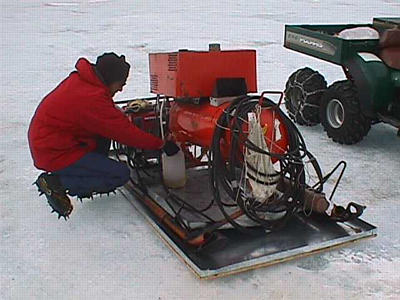
John using the used glycol bottle to top off the glycol reservoir. This burner boils glycol and sends the glycol through the coils to melt the ice.
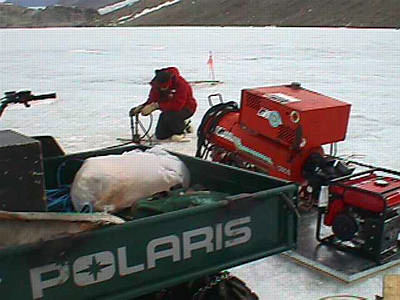
Me with the whole setup of melting out the sediment trap. In the foreground is the ATV (all terrain vehicle). Next you can see the generator and burner on the large drip pan (to catch any oil, glycol, or fuel that spills). The burner is the large red machine. I am situating the hot cylinder into the sediment trap hole. I'm trying to get the coil to burn as closely to the string of the sediment trap as possible. I want a straight hole down into the ice. This took about 5 hours to get through 4.5 m of ice!
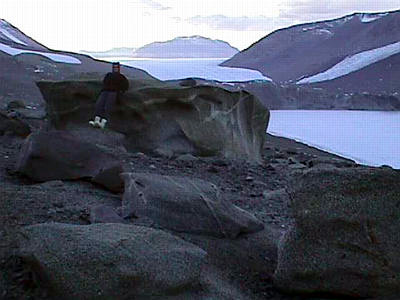
Me posing on one of those ventifacts I was talking about...and you know how big I am...aren't the rocks huge?
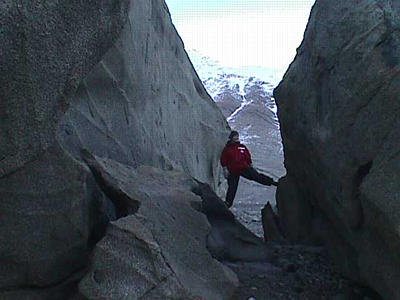
Nina posing between two of the biggest rocks we saw up on the mountain. You can see the glacier in the background.
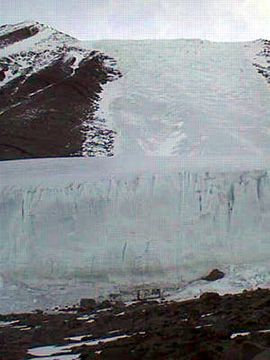
The foot of the glacier above our camp. It took us about 45 minutes to reach this point. If we were to really go up to it, we would be as tall as one of those rocks right in front of the glacier. The glacier is HUGE!
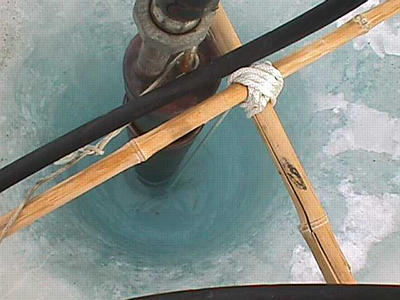
This is a picture looking down at the sediment trap hole. You can see that the rope leading to the sediment trap is frozen into the ice. The rusty coil is beginning to melt a hole down through the ice. As it melts downward, the warm water rises and causes the hole at the top to become much bigger.
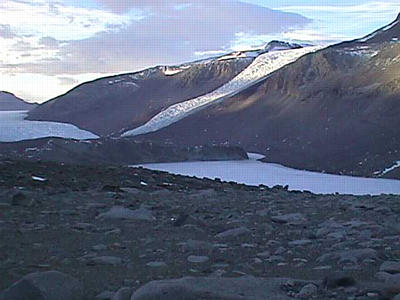
This is the view from up on top of the mountain behind our camp. At the far left, you can see Taylor Glacier. The piece of land jutting out into the picture is hiding the West Lobe of Lake Bonney, and the lake that you can see in the middle of the picture is the East Lobe of Lake Bonney, where our camp is. Beautiful, isn't it?
Contact the TEA in the field at
.
If you cannot connect through your browser, copy the
TEA's e-mail address in the "To:" line of
your favorite e-mail package.
|
